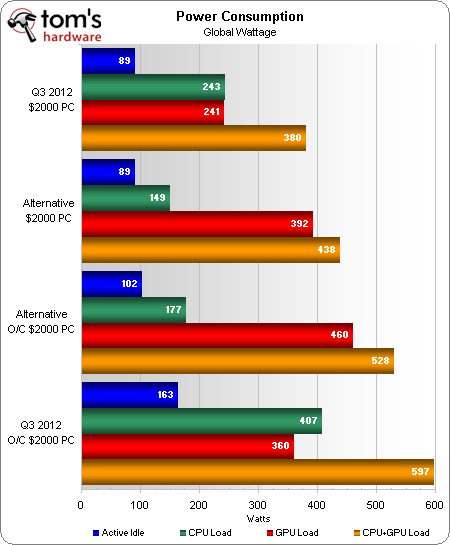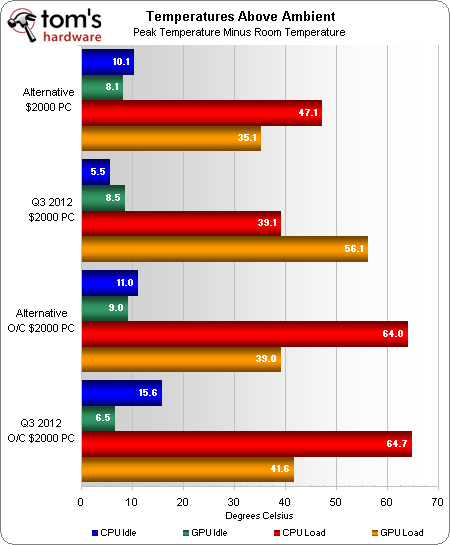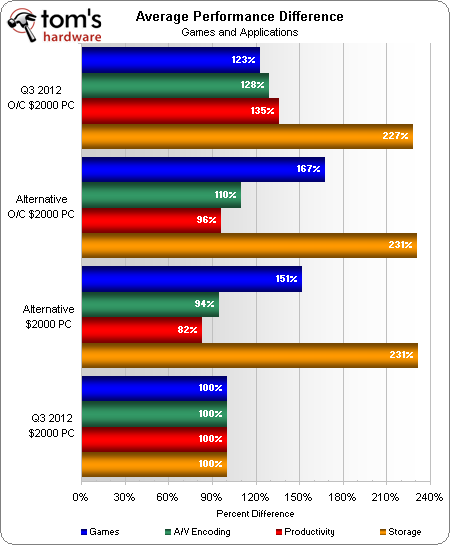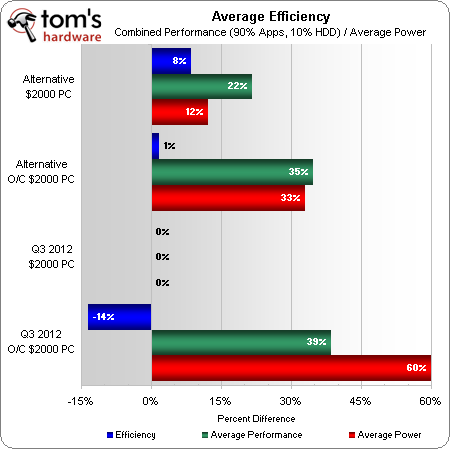System Builder Marathon, August 2012: Alternative $2000 Gaming PC
Power, Heat, And Efficiency
A newer, higher-efficiency architecture with fewer CPU cores doesn't help power consumption enough to make up for the fact that a second GeForce GTX 670 uses a lot of juice. Sure, it draws less power in applications able to tax the Core i5-3570K. However, pegging the graphics cards with heavy loads negate any advantage we might have seen from Ivy Bridge.
Although the CPU in today's machine generates less heat, we also equipped it with less cooling. Cost-conscious heat sinks and fans put both systems in the proverbial doghouse when they're overclocked and forced to contend with a demanding workload. We had to keep our room below 35° Celsius to keep them from throttling.
Our performance graph is organized by the average of averages, but that blue line matters more today. Gaming performance gains were our real goal, and we’re only hoping that gains there are enough to offset losses in other benchmarks. We used the original $2000 machine's stock settings as our performance and power baselines.
Heat is wasted power, and it looks like the PC with six cores generates heat far faster than the SLI-equipped gaming box when they're both overclocked. We could have guessed as much by simply by looking at the size of their coolers and the difference between baseline and overclocked temperatures, but our efficiency tests confirm our assumption. We end up seeing today's alternative configuration produce more work per watt, in spite of its thirsty pair of graphics cards.
Get Tom's Hardware's best news and in-depth reviews, straight to your inbox.
Current page: Power, Heat, And Efficiency
Prev Page Benchmark Results: Productivity Next Page Which $2000 Machine Is Right For You?-
zander1983 Now this is a $2000 machine. The 3930k is a nice-to-have, but not a need-to-have. If you need more horse power, swap the 3570k for a 3770k.Reply -
Crashman idroidnow THAT'S a real 2000$ PC, not the other 2000$Actually, this one is the fake, as in the experimental PC designed specifically for gaming. The other one was picked by reader recommendations, and that's why it made it into the "main event".Reply
That is to say, as much as this one costs, it's still pretty much worthless to the majority of high-end users. Basically it's a $1000 PC with a bunch of extras.
To put it another way, money "wasted" on the other one went towards making it more flexible and practical. Money "wasted" on this one went towards supporting future upgrades to its SLI array. It's nothing more than an expensive toy. -
brucek2 I enjoyed the article and am glad Tom's ran it. I agree with Crashman though about this being an experimental system: while I may rarely have call to exercise six cores, it is something that would come in handy from time to time. Meanwhile, I will never be gaming at 5760x1080. I'd get more value out of the original system.Reply -
dudewitbow orz, using blue ares ram and an antec eleven hundred together makes me think back to my wishlist changes I wish I could have gotten instead.(albeit im still deficient on other parts)Reply -
Crashman hmp_gooseWhy aren't they in portrait mode?Too narrow. The wide bezels are a major distraction when they're that close together. I think manufacturers should make some 5x4 or at least some 4x3 mid-sized displays specifically for this purpose.dudewitboworz, using blue ares ram and an antec eleven hundred together makes me think back to my wishlist changes I wish I could have gotten instead.(albeit im still deficient on other parts)Ares is cool because it lets you run pretty much any CPU cooler you want, without sacrificing memory frequency or timings.Reply -
EzioAs Reply9536498 said:Actually, this one is the fake, as in the experimental PC designed specifically for gaming. The other one was picked by reader recommendations, and that's why it made it into the "main event".
That is to say, as much as this one costs, it's still pretty much worthless to the majority of high-end users. Basically it's a $1000 PC with a bunch of extras.
To put it another way, money "wasted" on the other one went towards making it more flexible and practical. Money "wasted" on this one went towards supporting future upgrades to its SLI array. It's nothing more than an expensive toy.
Really? If it were me, I'd pick this one over the original $2000 PC. There are a lot more people gaming at 5760x1080 and 2560x1600 than they used to be so having more GPU performance is much more beneficial. Although that's primarily for the gamers, for other 3D purposes, video editing, etc the 6-cores 3930K and single GPU might be the best choice -
killabanks they are both great machines!! i personally think the sweet spot is somewhere around 1500 if you can get acceptable 5760x1080 performanceReply





